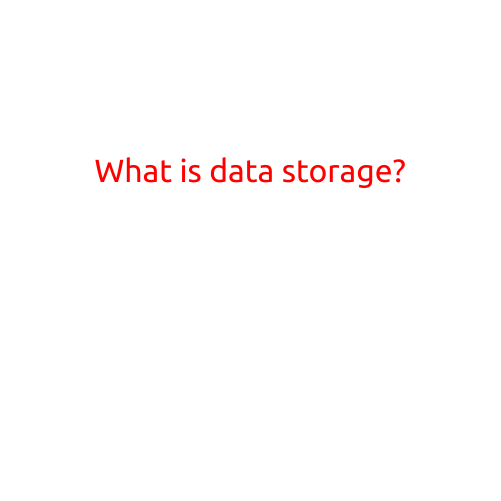
What is Data Storage?
In today’s digital age, data is a crucial component of many aspects of our lives. From storing personal photos and documents to managing large amounts of business data, the need for adequate data storage has become increasingly important. But what exactly is data storage, and how does it work?
What is Data Storage?
Data storage refers to the process of storing digital information in a way that allows it to be retrieved and accessed later. This information can take many forms, including text files, images, audio and video files, emails, and even large databases. The primary goal of data storage is to provide a reliable and efficient way to store and manage data, ensuring that it is available when needed.
Types of Data Storage
There are several types of data storage, each with its own unique characteristics and applications. Some of the most common types of data storage include:
- Internal Storage: This type of storage refers to the memory and storage devices located within a computer or device. Examples include hard drives, solid-state drives (SSDs), and random access memory (RAM).
- External Storage: External storage refers to devices and media that are separate from the computer or device. Examples include USB drives, external hard drives, and CDs/DVDs.
- Cloud Storage: Cloud storage refers to the practice of storing data online through cloud-based services. Examples include Google Drive, Dropbox, and iCloud.
- Distributed Storage: Distributed storage refers to the practice of storing data across multiple locations, such as in a network of computers or servers. Examples include cloud storage and peer-to-peer file sharing.
How Data Storage Works
Data storage involves a variety of technologies and processes that work together to store and retrieve data. Here’s a general overview of how data storage works:
- Data Generation: Data is generated through various sources, such as user input, sensors, or applications.
- Data Processing: The data is processed and formatted for storage using algorithms and software.
- Data Storage: The processed data is stored in a storage device or system, such as a hard drive or cloud storage service.
- Data Retrieval: When data is needed, the storage device or system retrieves the data and sends it to the requesting device or application.
- Data Management: Data management involves controlling and organizing data storage, including tasks such as backup, recovery, and data security.
Benefits of Data Storage
Data storage provides numerous benefits, including:
- Data Backup: Data storage allows for backup and recovery of important data, minimizing the risk of data loss.
- Data Security: Data storage provides a secure way to store sensitive data, protecting against unauthorized access and tampering.
- Data Availability: Data storage ensures that data is always available when needed, improving efficiency and productivity.
- Data Sharing: Data storage allows for easy sharing of data among multiple users and applications.
Conclusion
In conclusion, data storage is a critical component of our digital lives, providing a reliable and efficient way to store and manage data. Whether it’s internal, external, cloud, or distributed storage, data storage plays a vital role in ensuring that data is available when needed. By understanding the basics of data storage, we can better appreciate the importance of this technology and make informed decisions about how to store and manage our most valuable digital assets.





